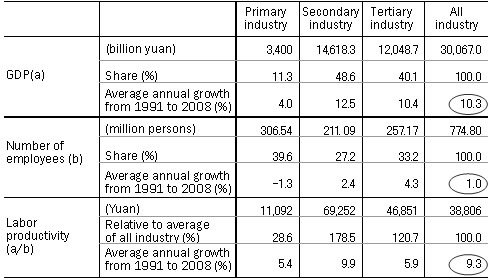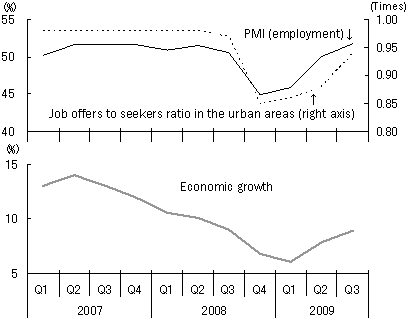China facing a trade-off between job creation and increasing productivity
In China, the creation of jobs has been an absolute must for the government, given the enormous pool of surplus labor that existed in rural areas. However, as the Chinese economy approaches the stage of full employment, the supply of labor is becoming a constraint on growth. To maintain high growth, the policy focus must be shifted from job creation to boosting productivity. This also conforms to the Chinese government policy of shifting the economy from "extensive growth" to "intensive growth."
While the average annual GDP growth from 1991 to 2008 was an impressive 10.3%, average annual growth in employment remains only 1.0% ( table 1 ). In China, there are many economists who see the current situation of high economic growth combined with low employment growth as a serious structural problem, calling it "growth without employment." The government, too, has been prioritizing the development of labor-intensive industries to ensure employment.
Table 1: GDP, employment and labor productivity by industry (2008)

(Source) Prepared based on the China Statistics Summary 2009.
Looking at the situation from a different angle, however, the fact that GDP has grown 10.3% annually while employment has risen by only 1.0% means that the average annual growth of labor productivity has reached 9.3%, making a substantial contribution to the economic growth. It is possible to see "growth without employment" as growth that is not dependent on increased employment (that is, growth attributable to a rise in labor productivity).
Thus assuming that GDP growth is a given, there is a trade-off between higher labor productivity and job creation. The decision as to which should be prioritized depends on supply and demand in the labor market. If unemployment is serious, job opportunities have to be created even at the expense of labor productivity. On the other hand, if full employment is achieved, the high growth in labor productivity must be maintained to sustain high economic growth.
The Chinese economy approaching the Lewis Turning Point
It has been widely believed that there are some 150 million people remaining underemployed or unemployed in the rural areas. This figure was also cited by the government in the National Population Development Strategy Research Report released in January 2007. Cai Fang, director of the Institute of Population and Labor Economics, Chinese Academy of Social Sciences (CASS), objects to this "surplus labor" hypothesis in his series of field studies on progression of the low birthrate and aging population and the depletion of surplus labor in rural areas associated with the massive population outflow. He has also demonstrated that China will reach a turning point known as the Lewis Turning Point, referring to the achievement of full employment in the course of its economic development, as early as 2009, and this argument has been drawing considerable attention.( note 1 )
Subsequently, demand for labor temporarily plummeted following the Lehman shock, and many migrant workers lost their jobs in urban areas and had to return home. Since the summer of 2009, however, labor supply has again tightened in step with the economic recovery, as indicated by the significant improvement in the job offers to job seekers ratio in urban areas (a similar concept to the effective job offer ratio in Japan) and the employment index of PMI ( figure 1 ).
Figure 1: Improving employment conditions associated with the economic recovery

(Note 1) The job offers to job seekers ratio in the urban areas of China is calculated by dividing the number of job offers by the number of job applicants registered in public employment service organizations in approximately 100 cities. It is based on the Analysis on Supply and Demand of Labor Market in Some Cities published quarterly by the China Labor Market Information Network Monitoring Center, which operates under the Ministry of Human Resources and Social Security.
(Note 2) The employment index of PMI reflects employment conditions in the PMI index (Purchasing Managers Index).
(Source) Prepared based on the National Bureau of Statistics of China, the Ministry of Human Resources and Social Security and the China Federation of Logistics & Purchasing.
Since it is likely that growth in overall employment will continue to decline and that the pace of the shift from primary to other industries will also slow as the workforce moves from surplus to shortfall going forward, it will be increasingly difficult to maintain the high economic growth seen in the past ( box ). Consequently, the focus of government policies will change from employment to productivity. In addition, if released from the shackles of having to create an enormous volume of job opportunities; China will "graduate" from the labor-intensive industries and accelerate the advance of its industries in the form of diverting resources to higher value-added areas. Signs of this have already appeared, as indicated by the leap forward made by heavy industries such as automobile and steel while labor-intensive industries are losing ground.
Box: Labor mobility between industries supported rises in GDP and labor productivity
Viewing from the supply side, GDP growth reflects increases in employment (labor input) and labor productivity, which in turn is influenced by growth in labor productivity in each industry and labor mobility between industes.
In China, labor productivity by industry is highest in secondary industry, in terms of both the absolute level and the growth rate and falls in the order of tertiary industry and then primary industry ( table 1 ). In addition to the rise in labor productivity in each industry, the mobility of labor from primary industry to secondary and tertiary industry also boosts labor productivity overall.
In fact, by decomposing GDP growth into the "increase in the number of employees" and "a rise in labor productivity," and the rise in labor productivity further into "a rise in labor productivity by industry" and "labor mobility between industries" using the data from 1991 to 2008, it is estimated that the contributions of the increase in the number of employees and the rise in labor productivity to GDP growth (10.3%) are 1.0% and 9.3%, respectively, while the contributions of the rise in labor productivity by industry and labor mobility between industries to the rise in labor productivity are 7.8% and 1.5%, respectively ( figure 2 ).
Figure 2: Breakdown of GDP growth and the rise in labor productivity (contribution)

(Source) Estimates by the author based on data from 1991 to 2008 in Table 1 .


